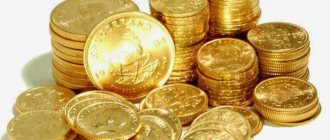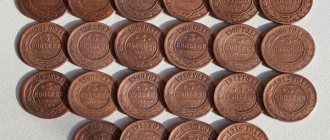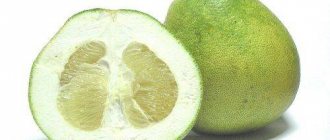Collecting ancient and rare coins is one of the popular hobbies of our time. Wanting to put exhibits in order, many people think about cleaning coins by electrolysis, since this method, despite its relative simplicity, is quite effective. Let's get acquainted with the nuances of this process and safety precautions.
Brief description of the method
The electrolysis method of cleaning products made of copper, nickel, bronze and other metals has found wide application among treasure hunters and collectors. With some experience and proper application, it allows you to achieve good results.
The complex physical and chemical process can be briefly described as follows:
- the electrodes are placed in a special solution;
- current is passed through them;
- due to electrical influence, certain substances are released at the electrodes;
- an electric field is created.
The method can be used even by those with little knowledge of electricity, but it is important to be careful.
How to clean copper coins?
Products made from this metal are less durable than silver coins, and therefore require careful handling. It is better to clean these types of coins without using aggressive agents. Because a patina forms on their surface, giving the products additional value. This layer prevents metal corrosion. If you find plaque on a coin, it is best to remove it without using aggressive means.
If there is corrosion on coins, it can be removed using chemicals. Trilon B and citric acid, as well as vinegar, are suitable for this It is necessary to keep the coin in these solutions for several hours until the desired result is achieved. It is worth noting that such solutions can remove the coating, that is, the protective film, from the surface. Therefore, you will have to re-patina.
Copper coins
Safety precautions
When working with an electrolysis cleaning device, you should follow simple rules that will make the process completely safe.
- Cleaning should take place in a bright room, with the window open.
- Closed clothing with long sleeves and rubber gloves will help protect your body.
- You can’t just plug the device into the network and leave; the process needs to be controlled.
- You should carefully select a power supply. Thus, the recommended operating voltage should not exceed 12 V. Otherwise, there is a high risk of electrocution.
Important!
It must be remembered that the work is carried out with current, so it is important to control each stage.
Precautions for the Electrolysis Method of Cleaning Antique Coins
At its core, the process of electrolytic cleaning of coins is a fairly safe procedure. It is important to take precautions here and everything will go as it should. For cleaning, choose a well-ventilated and lit area. It would be a good idea to use personal chemical and electrical protective equipment: rubber gloves, goggles, etc. Even though cleaning involves the use of a small electric current, precautions should not be neglected.
The process of cleaning finds by electrolysis proceeds quite quickly. In addition, this procedure is extremely simple from the point of view of execution. For example, soaking coins in soapy water or olive oil can take up to several months, while electrolysis cleaning rarely exceeds 1 hour. On the other hand, heating a coin in oil and then washing it is hardly feasible at home, because During the heating process, quite thick smoke may be released. You can carry out electrolysis without difficulty and without any consequences right in the kitchen. But it is important to understand that, despite its simplicity, the electrolysis cleaning method is a serious procedure, and it is almost impossible to control it without proper experience. Consequently, the risk of damage and even destruction of a coin or other artifact increases significantly.
Advantages and disadvantages of the method
Among the advantages of electrolysis cleaning of coins are the following.
- High speed (the procedure itself in rare cases will last more than 60 minutes, while soaking coins in olive oil can last more than 30 days).
- Ease of execution: all the work can be done in a regular kitchen.
- If the method is used correctly, the coin will not lose its quality and value for collectors.
- Electrolysis allows you to completely clean the product from oxides and patina.
We recommend: How to get rid of the smell of baby, cat or dog urine on the carpet
However, it is important to remember some of the disadvantages of the method.
- To fully control the process, you must have some experience or precise knowledge.
- There is a risk of making a mistake and damaging the product.
Despite these disadvantages, the technique is popular.
Cleaning coins by electrolysis (note to digger)
Home » Tips and recommendations » Cleaning coins by electrolysis (note to digger)
Date of publication: 08 August 2015 at 00:10
Coins and Electrolysis
Quite recently, I briefly touched on the topic of cleaning my finds, then the conversation was about cleaning copper coins. Well, since I remembered the previous topic, I repeat that for cleaning copper coins one of the best methods, recognized by many search engines, is guaranteed to be soaking the coins in soap followed by cleaning. The process is long but effective.
Well, for that category of treasure hunters who are “always in a hurry” and want to get a quick result, there is a method of cleaning coins that novice searchers are in awe of. This method... electrolysis . How to assemble the device itself - search on the Internet or consult with a familiar electrician. As a matter of principle, I do not describe the assembly of the device itself, so that “those who like to experiment” do not get into trouble.
Drawing on how to assemble an electrolysis device
It has long been known that using the electrolysis method you can clean metal objects, dating back to chemistry lessons. Many workshops use this property to give metal products certain characteristics. In general, the concept of electrolysis is not new, and with desire and some skill in working with electricity, most treasure hunters can independently assemble a simple “unit” for electrolysis.
Recall from the picture a chemistry textbook
Read on "E-KLAD": First metal trash, and only then treasure
What you need to know for electrolysis
IMPORTANT: WHEN ASSEMBLYING THE DEVICE YOURSELF, YOU ALWAYS NEED TO KNOW (ASSUME) ABOUT POSSIBLE CONSEQUENCES that can ruin your life. Well, revealing my cards a little, I note that many treasure hunters refuse electrolysis for the following reasons:
- You may get an electric shock
- In case of inept operation, a short circuit is possible
- Fire risk
- Risk of spoiling the find
- This is not always a controlled process
It is the fourth point that is especially interesting, since by accelerating the electrolysis process and observing how bubbles appear and the water bubbles and becomes cloudy, you can simply miss the moment when, along with the falling greenery, particles (residues) of metal from the find begin to pass into the solution, forming a relief the find itself.
The electrolysis process is often uncontrolled
And if we also take into account that there are not so many truly interesting finds and digging up something truly valuable (in the eyes of a search engine) is luck, then it is understandable what a disappointment will be when an object is extracted from the muddy water after electrolysis , once of interest, but now useless.
Findings after electrolysis are not always like new
Read on "E-KLAD": Peculiarities of treasure hunting in littered areas
Alas, electrolysis does not just clean coins, it cleans them in such a way that it would be better not to start this method. Precisely, based on this, before you start electrolysis, practice on poops in order to have an idea of what can happen and how the process goes, how long it is necessary to keep the coin in the solution, how many volts to set, and so on.
Train on poop
So it turns out that electrolysis seems to work in capable hands, but there is a “downside to the process” - this is a method that is difficult to control. And literally before your eyes, your find will turn from interesting and promising into a useless piece of metal. In addition to the above, do not forget that electrolysis is directly related to the use of electricity, which means there is a risk that something will suddenly go “in the wrong direction” and...
Here is one of the sad options for cleaning using electrolysis
To summarize (and I could write much more, but I think that the main idea can be traced), I note that it depends only on you and your accuracy and knowledge whether this method of cleaning coins will take its place of honor in your arsenal of methods and knowledge in the field of treasure hunting. And don’t rush to answer right away, think: weigh all the “+” and “-”.
Read on "E-KLAD": The quarter pillar is a good landmark in the forest
Yours, Alexander Maksimchuk! The best reward for me as an author is your like on social networks (tell your friends about this article), also subscribe to my new articles (just enter your email address in the form below and you will be the first to read them)! Don’t forget to comment on the materials, and also ask any questions you have about treasure hunting! I am always open to communication and try to answer all your questions, requests and comments! Feedback on our website works stably - don’t be shy!
Required Components
Let's look at what you need to prepare to use the electrolysis method to clean coins.
- Power unit. You can use any unit from household appliances, the operating voltage of which is 6-12 V. Options from mobile phones, old set-top boxes, and cameras are suitable.
Advice
If there is a need for electrolysis cleaning of a large number of products, you can purchase a universal power supply.
- Iron spoon or bolt. After electrolysis, such a product cannot be reused, so you should choose one that you don’t mind.
- Paper clip.
- Clothespins or special tucks.
- Plastic or glass glass with warm water.
- Salt or soda. For ½ liter you will need 3 tsp.
Advice
You should not use a very deep container - it is enough for the water to completely cover the coin.
What is prohibited from cleaning coins?
Do not use abrasive powders or rough tools to remove greenery from coins. Such impacts, and even with inept hands, can leave marks on the coin and damage the noble patina.
It is forbidden to use corrosive household chemicals, sandpaper, or rough metal brushes for cleaning.
You should not use very concentrated hydrochloric, nitric, acetic and sulfuric acids - their use can irreversibly damage the design of metal money.
Do not use a composition with ferric chloride to clean coins - this is a salt that is used to etch circuit boards, and it can corrode copper.
Coppers should not be exposed to high temperatures - this can cause the metal to begin to melt, which will damage its structure.
The first stage is preparing the device
The initial step that precedes the cleaning of copper and bronze coins by electrolysis is the assembly of a special device. Let's look at this process step by step.
- Preparing the wire from the power supply. The plug is cut off from it.
- The wire is divided into two parts, each of which must be exposed by about 5-7 cm.
- The next step is to identify the cathode and anode, this can be done simply with a glass of water and salt.
- Pour hot or warm water into a plastic glass. This will speed up the electrolysis process.
- Add salt (or soda) and stir thoroughly, since salt water conducts current better.
- Connect the power supply to the electrical network.
- Dip both wires into the liquid and observe the reaction. The one next to which the water begins to bubble slightly (a kind of hissing occurs) is positively charged. The second one is, accordingly, negative.
Having remembered which wire has a positive charge and which has a negative charge, the power supply from the network must be turned off.
We recommend: How much does it cost to clean a two-room apartment: compare prices in different regions of Russia
Electrolysis
Cleaning copper by electrolysis is only possible when the coin is not severely damaged and the oxides have not corroded deep cavities in the coin. This requirement is due to the fact that when cleaning by electrolysis, all imperfections will appear very clearly on the coin.
| Two kopecks from 1924 were purified by electrolysis. A solution of baking soda was used as an electrolyte, and a charger for a car battery (12V, 2A) was used as a current source. Cleaning time 5 minutes. |
Electrolysis cleaning technology is that a coin is attached to the “-” (cathode) of a direct current source, and either a graphite element or any object made of the same material as the coin itself is attached to the “+” (anode). Next, the anode and cathode are immersed in the electrolyte and current is applied. As an electrolyte, you can use a solution of baking soda in water (2 tablespoons per liter). The cleaning process takes from several minutes to an hour depending on the size of the coin, its condition and the power of the current source.
Preparing for cleaning
So, the device for electrolysis at home is ready. Now you need to prepare the coin and begin the process. How it's done?
There are two cleaning methods.
- During the first, aggressive one, the coin is attached to the “plus”. In this case, the cleaning process will go faster.
- In the second case – to the “minus”. The process is easier to control, but it will take longer.
Having chosen a method (for beginners it is best to start with the second and first clean the product, which is not of particular value), you need to attach the coin and the iron product to the wires.
First, a paper clip is attached to the selected wire; it will securely hold the coin. An iron object is attached to the other.
Advice
To clean rare and valuable copper coins, it is best to choose a more gentle method by connecting the product to the minus.
How is the procedure done?
Step-by-step cleaning description:
- first, disconnect the stamp from the adapter and expose the wires;
- then install clamps to each wire;
- prepare a solution for the procedure;
- find out which terminal the negative charge goes to and which the positive charge goes to.
A wire with a positive charge should go to the spoon, and a wire with a negative charge should go to the coin. If you can’t figure out the wires yourself and you don’t have a tester at hand, you need to place a spoon and a coin in the water so that they don’t touch each other. If a wire carrying negative current is connected to a spoon, it will begin to bubble; if this wire is connected to a coin, it will begin to bubble.
Electrolysis cleaning steps
The minus is not capable of harming the metal of the coin, but it is still worth carefully monitoring its condition. Periodically remove the product from the solution and check the degree of cleaning.
Observing the process, you can see how dirt peels off the surface of the metal and moves away. Cleaning coins involves changing the color of the solution. During the procedure, it is able to change color, darken and turn black. This happens not only because the dirt moves away from the metal, but also because the clamps in the solution oxidize.
After the procedure, it would be useful to polish the money - they must be rinsed under a stream of water, and the surface cleaned with a toothbrush. The surface of the metal is then polished using a piece of suede. If there is no suede, then wool without lint and pellets will do.
During the cleaning process, you may notice how the surface of the coin becomes covered with black flakes. You can easily get rid of them by brushing: for this you need to periodically check the degree of contamination of the product, removing it from the solution every 15 minutes.
Don't go overboard as cleaning with electrolysis can cost you money. Minor damage may form on the metal surface and the patina will disappear.
If the dirt stuck to the coin cannot be cleaned, then you should not experiment and repeat the procedure using electrolysis; it is better to give the coin to a restorer for cleaning.
Recommendations for cleaning and care
The duty of any collector is to ensure that metal monetary exhibits are preserved in such a way that a noble patina can form. It is evidence of the age of the coin and will protect the exhibit from environmental influences. Unlike dirt stains, a true patina will cover not only the depressions on the surfaces, but also the unpatterned field.
- Metal money requires constant care, as it is very sensitive to environmental influences. Therefore, they should be stored in special packaging, and constant exposure to light and in an open state will lead to their oxidation and contamination.
- From time to time such banknotes should be cleaned. To do this, they are dipped into a container with a hot solution of laundry or baby soap and water. When the layer of dirt on the money softens a little, you need to very carefully clean all the dirt with a soft sponge.
- For silver coins with purity less than 625, ammonia is suitable. And higher purity silver coins can be cleaned with lemon juice or kept in it for a while.
It is best to use special products for caring for coins. Such drugs are sold in specialized stores. A novice numismatist can use improvised means to remove light stains.











